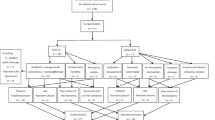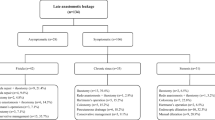Abstract
Background
Data regarding anastomotic leakage (AL) following intersphincteric resection (ISR) are lacking. We aimed to evaluate the effect of AL on anal function in a retrospective review of patients who developed AL following ISR.
Methods
We evaluated 341 consecutive patients who underwent ISR between 2000 and 2012. Patients were classified into three groups: anastomotic dehiscence (AD), major AL (Clavien–Dindo grade III+), or control (<grade III or no AL). Functional assessment was performed at 3, 6, 12, and 24 months after defecation through the preserved anus, and the Wexner score was calculated.
Results
Among patients who underwent ISR for low rectal cancer (anal verge, 3.7 ± 1.3 cm), 59 (17%) developed AL. Of these, 13 patients were classified as AD and 36 as major AL. The rate of the 3-year stomal reversal was significantly lower in the major AL (78.6%) and AD groups (61.5%) than in the control group (88.7%; p < 0.01). Furthermore, the anastomotic stricture rate was higher in the AL and AD groups than in the controls (16.7 and 38.5 vs. 1.8%, respectively; p < 0.01). Wexner scores in the major AL group were poor during the early period, but were similar to the control group at the 2-year follow-up. In contrast, Wexner scores in the AD group remained high, even after 2 years.
Conclusions
Patients with major AL following ISR had poor anal function that recovered over 2 years, as long as AD was not present. These findings suggest that patients with major AL require a long-term follow-up for anal function.





Similar content being viewed by others
References
Saito N, Sugito M, Ito M et al (2009) Oncologic outcome of intersphincteric resection for very low rectal cancer. World J Surg 33:1750–1756. doi:10.1007/s00268-009-0079-2
Martin ST, Heneghan HM, Winter DC (2012) Systematic review of outcomes after intersphincteric resection for low rectal cancer. Br J Surg 99:603–612
Ito M, Saito N, Sugito M et al (2009) Analysis of clinical factors associated with anal function after intersphincteric resection for very low rectal cancer. Dis Colon Rectum 52:64–70
Saito N, Ito M, Kobayashi A et al (2014) Long-term outcomes after intersphincteric resection for low-lying rectal cancer. Ann Surg Oncol 21:3608–3615
Choi HK, Law WL, Ho JW (2006) Leakage after resection and intraperitoneal anastomosis for colorectal malignancy: analysis of risk factors. Dis Colon Rectum 49:1719–1725
Ptok H, Marusch F, Meyer F et al (2007) Impact of anastomotic leakage on oncological outcome after rectal cancer resection. Br J Surg 94:1548–1554
Mirnezami A, Mirnezami R, Chandrakumaran K et al (2011) Increased local recurrence and reduced survival from colorectal cancer following anastomotic leak: systematic review and meta-analysis. Ann Surg 253:890–899
Saito N, Ono M, Sugito M et al (2004) Early results of intersphincteric resection for patients with very low rectal cancer: an active approach to avoid a permanent colostomy. Dis Colon Rectum 47:459–466
Saito N, Moriya Y, Shirouzu K et al (2006) Intersphincteric resection in patients with very low rectal cancer: a review of the Japanese experience. Dis Colon Rectum 49:S13–S22
Dindo D, Demartines N, Clavien PA (2004) Classification of surgical complications: a new proposal with evaluation in a cohort of 6336 patients and results of a survey. Ann Surg 240:205–213
Osera S, Ikematsu H, Odagaki T et al (2015) Efficacy and safety of endoscopic radial incision and cutting for benign severe anastomotic stricture after surgery for lower rectal cancer (with video). Gastrointest Endosc 81:770–773
Denost Q, Laurent C, Capdepont M et al (2011) Risk factors for fecal incontinence after intersphincteric resection for rectal cancer. Dis Colon Rectum 54:963–968
Nesbakken A, Nygaard K, Lunde OC (2001) Outcome and late functional results after anastomotic leakage following mesorectal excision for rectal cancer. Br J Surg 88:400–404
Hallbook O, Sjodahl R (1996) Anastomotic leakage and functional outcome after anterior resection of the rectum. Br J Surg 83:60–62
Bittorf B, Stadelmaier U, Merkel S et al (2003) Does anastomotic leakage affect functional outcome after rectal resection for cancer? Langenbecks Arch Surg 387:406–410
Carmona JA, Ortiz H, Perez-Cabanas I (1991) Alterations in anorectal function after anterior resection for cancer of the rectum. Int J Colorectal Dis 6:108–110
Jorge JM, Wexner SD (1993) Etiology and management of fecal incontinence. Dis Colon Rectum 36:77–97
Devroede G, Vobecky S, Masse S et al (1982) Ischemic fecal incontinence and rectal angina. Gastroenterology 83:970–980
Rajasekaran MR, Sinha S, Seo Y et al (2014) Myoarchitectural and functional alterations in rabbit external anal sphincter muscle following experimental surgical trauma. Am J Physiol Gastrointest Liver Physiol 307:G445–G451
Ashburn JH, Stocchi L, Kiran RP et al (2013) Consequences of anastomotic leak after restorative proctectomy for cancer: effect on long-term function and quality of life. Dis Colon Rectum 56:275–280
Rullier E, Laurent C, Garrelon JL et al (1998) Risk factors for anastomotic leakage after resection of rectal cancer. Br J Surg 85:355–358
Kim JS, Cho SY, Min BS et al (2009) Risk factors for anastomotic leakage after laparoscopic intracorporeal colorectal anastomosis with a double stapling technique. J Am Coll Surg 209:694–701
Eriksen MT, Wibe A, Norstein J et al (2005) Anastomotic leakage following routine mesorectal excision for rectal cancer in a national cohort of patients. Colorectal Dis 7:51–57
Ito M, Sugito M, Kobayashi A et al (2008) Relationship between multiple numbers of stapler firings during rectal division and anastomotic leakage after laparoscopic rectal resection. Int J Colorectal Dis 23:703–707
Akasu T, Takawa M, Yamamoto S et al (2010) Risk factors for anastomotic leakage following intersphincteric resection for very low rectal adenocarcinoma. J Gastrointest Surg 14(1):104–111
Koyama M, Murata A, Sakamoto Y et al (2015) Risk factors for anastomotic leakage after intersphincteric resection without a protective defunctioning stoma for lower rectal cancer. Ann Surg Oncol 23:249–256
Shiomi A, Ito M, Maeda K et al (2015) Effects of a diverting stoma on symptomatic anastomotic leakage after low anterior resection for rectal cancer: a propensity score matching analysis of 1014 consecutive patients. J Am Coll Surg 220:186–194
Funding
Grant support for this study was provided by a National Cancer Center Research and Development Fund (25-A-8).
Author information
Authors and Affiliations
Corresponding author
Ethics declarations
Conflict of interest
None.
Rights and permissions
About this article
Cite this article
Yokota, M., Ito, M., Nishizawa, Y. et al. The Impact of Anastomotic Leakage on Anal Function Following Intersphincteric Resection. World J Surg 41, 2168–2177 (2017). https://doi.org/10.1007/s00268-017-3960-4
Published:
Issue Date:
DOI: https://doi.org/10.1007/s00268-017-3960-4




